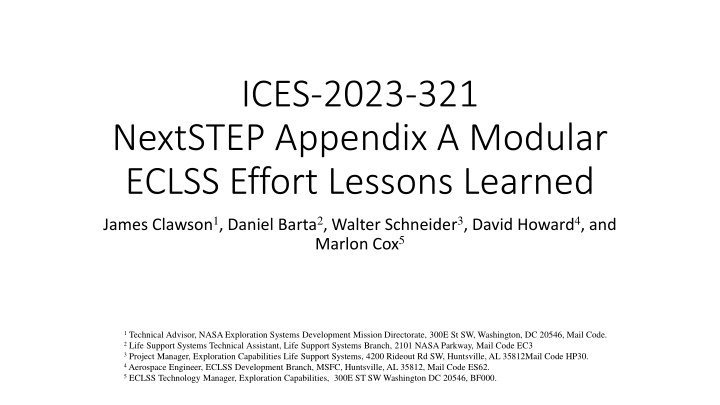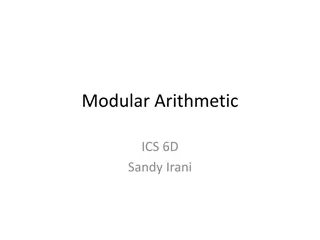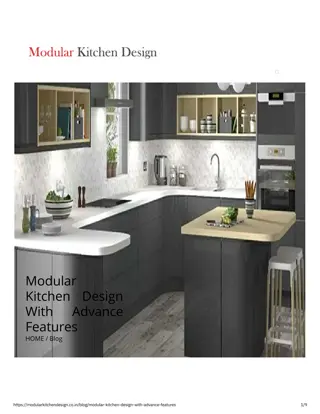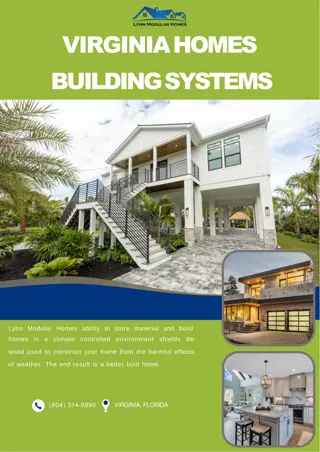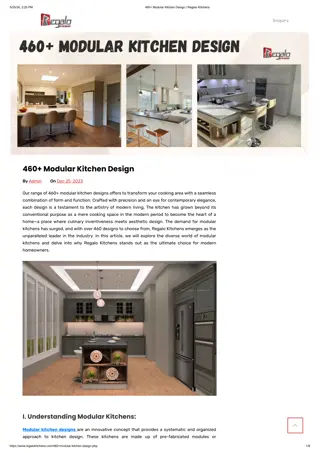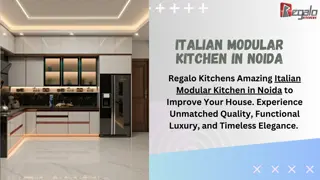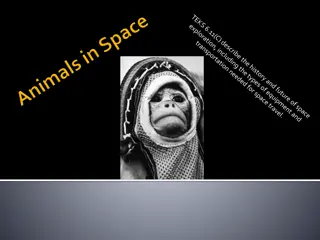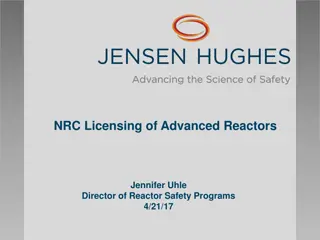Advancing Deep Space Exploration Capabilities: NextSTEP Modular ECLSS Effort
The Next Space Technologies for Exploration Partnerships (NextSTEP) program, initiated in 2015, focused on enhancing deep space habitation capabilities through a public-private partnership. The Modular ECLSS Effort aimed to develop adaptable ECLSS systems for various exploration missions. It involved studying key topics, developing modular concepts, and exploring intelligent systems. The program concluded in 2022, marking a significant milestone in NASA's goal of enabling long-duration human missions in deep space.
Download Presentation

Please find below an Image/Link to download the presentation.
The content on the website is provided AS IS for your information and personal use only. It may not be sold, licensed, or shared on other websites without obtaining consent from the author.If you encounter any issues during the download, it is possible that the publisher has removed the file from their server.
You are allowed to download the files provided on this website for personal or commercial use, subject to the condition that they are used lawfully. All files are the property of their respective owners.
The content on the website is provided AS IS for your information and personal use only. It may not be sold, licensed, or shared on other websites without obtaining consent from the author.
E N D
Presentation Transcript
ICES-2023-321 NextSTEP Appendix A Modular ECLSS Effort Lessons Learned James Clawson1, Daniel Barta2, Walter Schneider3, David Howard4, and Marlon Cox5 1 Technical Advisor, NASA Exploration Systems Development Mission Directorate, 300E St SW, Washington, DC 20546, Mail Code. 2 Life Support Systems Technical Assistant, Life Support Systems Branch, 2101 NASA Parkway, Mail Code EC3 3 Project Manager, Exploration Capabilities Life Support Systems, 4200 Rideout Rd SW, Huntsville, AL 35812Mail Code HP30. 4 Aerospace Engineer, ECLSS Development Branch, MSFC, Huntsville, AL 35812, Mail Code ES62. 5 ECLSS Technology Manager, Exploration Capabilities, 300E ST SW Washington DC 20546, BF000.
Topics Hazard Timeline Analysis Palletization Functional Groups Commonality Temperature/Humidity Control Scaling and Disaggregation Evolving Open to Closed Loop Maintenance Units Augmented Reality Integrated Modular Control Architecture Intelligent Systems
NextSTEP App A Modular ECLSS Effort Intro Next Space Technologies for Exploration Partnerships (NextSTEP) Broad Agency Announcement (BAA) effort was a public-private partnership aimed at advancing deep space exploration habitation capabilities. The program was launched in 2015 to leverage available industry existing or planned capabilities in Low Earth Orbit (LEO) to help define feasible potential habitation architecture concepts that address NASA s objectives for deep space missions. NASA awarded four habitation concept study contracts through the NextSTEP BAA under three areas; Transportation, Habitation, and Operations & Environment. One contract was awarded to Hamiltion Sundstrand Space Systems International, Inc. (now Collins Aerspace) Develop concepts that group ECLS systems into logical modules maximizing the use of common components and the development of unique methods and design concepts that support in-flight maintenance and repair for [ ] future exploration systems. Arose from the notion of a universal environmental control and life support system (ECLSS) that is adaptable to multiple exploration platforms and missions embodying the key characteristics of Evolvability, Resiliency, Modularity, Affordability, and Intelligence. The initial scope of the effort involved studying various topics such as identifying driving requirements, outlining baseline NextSTEP technologies, developing initial safety considerations, developing a modularized pallet concept, grouping subsystems together, and performing an in-flight maintenance study. Modular ECLSS effort continued under the NextSTEP-2 program in 2017 continuing to mature the concepts addressed in Phase 1 while adding new tasks to the Phase 2 effort Phase 2 included developing an Integrated Control Architecture, defining ECLSS Standards and Habitat Interface, exploring the use of intelligent systems, developing of a functional Air Revitalization System Prototype, studying methods for in-flight maintenance, and more. A Phase 2 extension continued the development of the functional Atmosphere Revitalization System (ARS) pallet to include a full capacity Thermal Amine Scrubber and added the refinement of the pallet design to decouple the structure required to withstand launch loads from the structure required on-orbit The NextSTEP Modular ECLSS effort came to a close in 2022. Significant step forward in the development of deep space exploration capabilities The lessons learned contribute to NASA s progress towards its goal of enabling long-duration human missions in deep space
Analysis of the Hazard Timeline Hazard timeline analysis reveals the potential benefits of various strategies on increasing the time margin to hazardous conditions as a result of failures
Palletization Universal Pallet Initial pallet form factor Translation into and through hab for on-orbit outfitting Features allow for access to all sides for maintenance Advanced Pallet Decouples structure required for launch from on-orbit Lighter weight Highly configurable Palletization allows integration and testing of ECLSS parallel to habitat production or to enable post- launch outfitting to enable plug and play capability for maintenance or evolution
Functional Groups Functional Grouping facilitates the modularization of the ECLSS system and minimizes the interfaces between pallets
Commonality Investigated two classes of components for commonality potential, sensors and solenoid valves Existing complement of systems employ 23 unique solenoid valves Learned it was infeasible to replace all instances with a single valve design Discovered it was possible to design a common electrical coil assembly that would add initially deployed mass that would likely be offset by the mass savings in reducing the number and types of spares across the system Existing complement of systems employ 24 unique pressure sensors and 13 unique temperature sensors Learned that existing technology cannot significantly reduce the number of unique sensors New optical sensor technology conceivably enables replacing with one unique temperature and one unique pressure sensor Commonality reduces unique parts count thus reducing acquisition and spares/supportability costs
Temperature/Humidity Control Scaling and Disaggregation Habitat Volume Small (45 m3) Medium (125 m3) Large (200 m3) XL (200 m3) 300 CFM 600 CFM 900 CFM 900 CFM Minimum Ventilation Rate 1 kW 2.5 kW 4 kW 6 kW Maximum Parasitic Sensible Heat Load 1 2 2 3 Ventilation/THC Pallet Count 0 0 1 0 Disaggregated Ventilation Fan Count Palletization enables scaling of temperature / humidity control capability to match habitat volume and internal equipment heat loads
Evolving Open to Closed Loop 3x 30-day Missions + 12x 90-day Missions 15x 30-day Missions Closed-loop, or regenerative, life support systems pay for themselves quickly in terms of logistics mass delivery
Maintenance Units (MU) Learned that component-level removal and replacement resulted in increased weight, volume, complexity, and cost. Maintenance Units, like Orbital Replacement Units, aggregate components but are designed to be fixed onboard. MU boundaries are influenced by: considering if it is safe to remove a component or if a higher-level removal is required how many working fluids are interrupted by MU removal; fewer is better what kind of working fluid is interrupted; is it hazardous? what testing can be done at the work station to verify acceptance-level performance how accessible is the hardware; is the MU easily removed (# of Q.D s) what type of failure is being addressed (e.g. electrical vs. mechanical)
Augmented Reality Augmented reality can effectively guide crews during maintenance and repair procedures potentially improving maintenance success and reducing time to repair
Integrated Modular Control Architecture The distributed control architecture behaves as an Internet of Things with independence and redundancy that provides a more resilient system than the current Federated Systems.
Intelligent Systems The ability of intelligent systems to predict inevitable fault conditions before actual failure increases the margin for time to hazardous conditions.
Conclusion Initiated with the goal of achieving ECLS systems embodying the key characteristics of Evolvability, Resiliency, Modularity, Affordability, and Intelligence Evolvability Palletization offers the flexibility to integrate systems after launch, which can address the evolution of a habitat s ECLSS from open- to closed-loop The use of standard rack interfaces allows swapping out of the existing systems with new improved technology and combined with the integrated modular control architecture this essentially enables a plug and play capability to reconfigure the pallets over time Resiliency Hazard timeline analysis reveals the potential benefits of various strategies on increasing the time margin to hazardous conditions as a result of failures. Bayesian network-based intelligent systems can potentially predict and isolate pending faults at the component level prior to the occurrence of a fault condition Integrated Modular Control Architecture provides extra levels of controller redundancy to improve resiliency Modularity Component-level removal and replacement was found to increase weight, volume, complexity, and cost Maintenance Units limited the interface disruption within the pallet and better balanced the benefits of modularity against the weight and complexity of applying interface controls to every component Augmented reality efficiently guided crewmembers through the repair, which improved timeliness of repairs with reduced reliance on prior knowledge or training Affordability Universal and Advanced pallets enable easy installation of ECLSS in diverse platforms promoting reuse Commonality reduces unique parts count reducing acquisition and spares/supportability costs The Integrated Modular Control Architecture and common software approach improves independence and redundancy for a more adaptable architecture Intelligence The integrated modular control architecture behaves as an Internet of Things with independence and redundancy that provides a more resilient system than the current Federated Systems Bayesian Net intelligent health monitoring system proof-of-concept demonstrated the ability to predict and isolate pending faults, which also provides crews extra time to balance workloads while avoiding hazardous conditions
